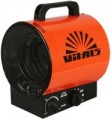Max. thermal output
The highest heating power produced by an industrial heater.
The maximum area that the unit can effectively heat directly depends on this parameter (see below). Even if it is not indicated in the specs, it can be approximately determined from the calculation that for heating 1 m² of a room with a standard ceiling height of 2.5 m and good thermal insulation will require 100 W of thermal power. If the ceiling height is significantly different, then the power required for heating can already be withdrawn from the volume of the room — every 2.5 cubic metres of volume will require the same 100 W (and the volume is found by multiplying the area by the height of the ceiling). There are also more complex formulas for the most accurate calculation, taking into account the degree of thermal insulation, the temperature difference between inside and outside the room, etc.; they can be found in special sources.
Note that in electric models (see "Power supply"), the maximum thermal power, in addition to all of the above, also determines the total power consumption of the unit: the power consumption (see below) cannot be less than the thermal output (usually, it is somewhat higher due to for the removal of part of the energy for the operation of the fan). In devices with a water circuit, the actual thermal output depends on the temperature of the coolant at the inlet and outlet. Therefore, in the characteristics, a certain standard value is usually indicated, and in t...he notes, it is specified for which temperatures it is relevant (for example, 90 ° / 70 °).
Max. heating area
A very conditional parameter that slightly characterizes the purpose by the size of the room. And depending on the height of the ceilings, the layout of the room and the equipment, the actual values may differ significantly. Nevertheless, this item represents the maximum recommended area that the heat gun can effectively heat.
When determining the maximum area, usually, a universal formula is used that is valid for all heaters: 1 m² of floor space in a room with a standard ceiling height of 2.5 m requires 100 W of thermal power. Therefore, if the ceiling height differs markedly from this value, the actual heating area should be recalculated; for more details on scaling, see “Maximum thermal output".
Airflow
The maximum amount of air that an industrial heater can pass through itself in a certain time.
This parameter is associated with an increase in air temperature (see above): at constant power, higher performance usually corresponds to a smaller temperature difference. Accordingly, a more efficient industrial heater will heat the entire volume of the room faster, but the heating temperature will be lower. So, it is worth choosing according to this parameter, taking into account what is more important for you — a large temperature difference or a high heating rate.
Tilt adjustment
The ability
to change the tilt angle of the industrial heater. Thanks to this, you can adjust the direction of the air flow not only horizontally (by turning the unit), but also vertically — for example, direct heat to the wall section that needs to be dried first.

